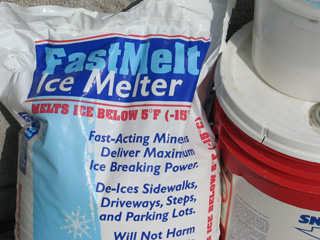Choosing Appropriate Ice Melt Products
Selecting the appropriate ice melt product can go a long way in protecting water quality. This podcast details the typical sources homeowners can find and stresses the importance of not applying nitrogen and phosphorus-based fertilizers as ice melt materials.

Significant threats of snow and ice will remain across much of Virginia from January through March. For safety reasons (both vehicular and pedestrian) in our region, there is plenty plenty of justification to use chemicals commonly referred to as “ice melt” or “salt” on roads, sidewalks, and hardscapes.
Standard ice melt compounds are usually some form (or combination of) chloride-based salts (calcium chloride, magnesium chloride, potassium chloride, or sodium chloride are typically the most readily available and cheapest ice melt compounds) and it is one of these compounds that is typically applied by VDOT during inclement weather.
Many towns and cities have their own local statutes regarding mandatory snow and ice removal from sidewalks within a given time period following snow or ice events for both business and residential situations alike. It is hard to argue against the importance of treating streets and sidewalks for public safety in such hazardous conditions. At the same time it is important to ensure that appropriate “ice melt” chemicals are selected so as to minimize possible environmental effects.
The chloride-based salts are generally considered to be some of the most environmentally friendly products available for this use. However, anyone that has lived in the north understands how corrosive even these materials can be to your vehicles and/or roadside vegetation.
Did you recognize the names of some of these salts? One of them is likely on your kitchen cabinet right now, sodium chloride (or table salt). Potassium chloride is likely in your garden shed as it is known by most as muriate of potash, the 0-0-60 lawn and garden fertilizer so common at garden centers. Are you a fan of home-made ice cream? If so, then it is likely you have added rock salt (might be any one of these compounds) to your ice cream freezer to accelerate the hardening of the mix. Using salt to increase the speed of making ice cream applies the same chemistry principles that result in salt applications to streets and sidewalks melting ice. Salts lower the freezing/melting point of water from 32° F. In general most commercially available salts work quite well at preventing ice formation to temperatures as low as 15° F and beyond this temperature there are only a very few specialized salt formulations that result in ice melt to temperatures as low as 5° F.
There also is another product that homeowners might consider if they can find it: calcium magnesium acetate (CMA). This material is one of the safest deicing products because it has very low corrosive potential, meaning less damage to cars, vegetation, sidewalks etc. CMA is biodegradable and its ice melt properties are comparable to most standard salt formulations, but its biggest limitation to use is typically a cost that can be 20-30 times more than traditional rock salt products. However, if only needed for relatively small areas around homes, cost won’t be nearly as critical.
The point of this article is not to provide a chemistry lesson, but strangely enough given the time of year, the reason is protect water quality. Mother Nature effectively deals with most recommended salt applications by way of an appreciable diluting effect of these salts due to rainfall etc. Environmental impact from recommended salt sources is typically minimal. However, there are some forms of ice melt that get marketed during icy conditions that can and do have serious environmental implications: traditional lawn and garden fertilizers containing nitrogen (N) and phosphorus (P).
A few years ago, I received word that one of our state’s big box retailers was selling urea (46-0-0) and 10-10-10 as “ice melt”. I doubt the sales staff had any idea of the concerns with these materials. However, there is no quicker way to contaminate water resources than to apply N and P-based fertilizers to hardscapes where water intentionally is channeled to storm drains for removal. From an environmental standpoint, direct applications of N and P-containing fertilizers to streets and sidewalks make no more sense now than they do in the middle of summer, especially since there are more environmentally friendly options for ice melt available.
The take-home message is simple: do a little research before choosing and applying ice melt materials and make sure the product is not a N and P-based fertilizer. Regardless of the season, it is always important to protect our water resources.
About this File
Author: Mike Goatley
Release Date: December 3, 2012
Length: 04:51
Link: Choosing Appropriate Ice Melt Products
Contact Turf and Garden Tips
Please contact your local Extension office for more information related to your turf and garden questions.


